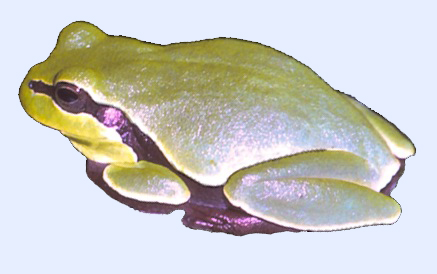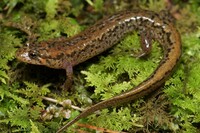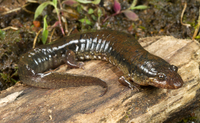Taxonomy
Class: AmphibiaOrder: CaudataFamily: PlethodontidaeSubfamily: PlethodontinaeAuthor: Pyron and Beamer, 2023
Taxonomic Comments: The Spotted Dusky Salamander (Desmognathus conanti ) and Northern Dusky Salamander (D. fuscus ) as traditionally recognized by herpetologists have a long and complex taxonomic history, with the former originally described as a subspecies of D. fuscus . It was treated as such until genetic studies revealed that it is not closely related to the latter (Beamer and Lamb 2008; Kozak et al. 2005). According to the latest systematic treatment of these species by Pyron and Beamer (2023a) At least 10 other currently recognized species of Desmognathus were either described from populations previously considered to be D. fuscus , described as or later considered to be subspecies of D. fuscus , or later considered to be synonyms of D. fuscus before ultimately being recognized as distinct species. The latest molecular analyses have also revealed extensive cryptic diversity within both D. conanti and D. fuscus as currently conceived, with these two species constituting a polyphyletic assemblages of 13 distinct mitochondrial lineages and perhaps as many as 11 candidate species. Pyron and Beamer (2023a) provide a very comprehensive review of the taxonomic history of this group. Desmognathus species and lineages. Gene exchange has occurred between both phylogenetically sister and geographically adjacent populations, as well as between distantly related and spatially separated groups. In summary, both D. conanti and D. fuscus are now each known to represent polyphyletic assemblages of multiple, geographically well-defined candidate species that are phylogenetically interdigitated with other recognized species. The candidate species include a “mountain dusky”phenotype with smaller, gracile bodies and round tails, a lowland “dusky” type with more robust, larger bodies and keeled tails, and a smaller lowland “dusky” form often associated with ravine streams and adjacent swamps, with slenderer bodies and less heavily-keeled tails.D. conanti and D. fuscus , the authors recognized six additional species based on genetic, geographic, and morphological evidence. They also redefined D. conanti and D. fuscus . The new species are D. anicetus , D. bairdi , D. campi , D. catahoula , D. lycos and D. tilleyi . Among the newly described species, all but D. catahoula occur in North Carolina. Species Comments:
Identification
Description: Desmognathus lycos is a relatively large and robust member of the D. fuscus complex, with metamorphosed individuals varying from 22–74 mm SVL (Pyron and Beamer, 2023a). The tail is triangular in cross-section on the distal half and has a keel. The toes lack dark, cornified tips as seen in some Desmognathus species. Specimens can range from being boldly patterned on the dorsum to being rather drab, with variation occurring both within and between local populations. A distinct dorsal color pattern is typically present in young individuals, but commonly becomes obscure with age and is replaced by a solid dull orange or dark-brown wash or stripe. A line of blackish blotches or irregular spots along the edge of dorsal stripe helps to separate the dorsal and lateral coloration, with the lower sides becoming more speckled with whitish to yellowish-white coloration. The venter of adults is mostly whitish or cream-colored with dark, pinpoint stippling or speckling that originates mostly around the lateral margins and extends more sparsely towards the center (Pyron and Beamer, 2023a). The proximal portion of the underside of the tail often has a faint yellowish wash. Desmognathus lycos is parapatric with D. fuscus in northern Wilkes County, with D. lycos mostly in the Piedmont and D. fuscus in the Blue Ridge and along the Blue Ridge Escarpment. The patterning on the belly may be the best way to separate the two, with D. fuscus having a uniformly speckled belly of yellowish, whitish, and bluish flecks, versus a paler white belly with scattered and small dark speckles invading from the lateral margins (Pyron and Beamer, 2023a). Desmognathus lycos also is parapatric with D. bairdi at several localities in the central Piedmont. The latter species is more of a lowland form and has a more slender or gracile body form relative to D. lycos . In addition, many adult specimens have a second row of light-colored portholes on the dorsolateral surfaces. Online Photos: Google iNaturalist AmphibiaWeb Account
Distribution in North Carolina
Distribution Comments: Desmognathus lycos has an unusual horseshoe-shaped distribution around the range of D. bairdi . It occurs from the Coastal Plain of southeastern Virginia and northeastern North Carolina through the western Piedmont and adjacent Blue Ridge foothills of central North Carolina where it comes into close contact with D. fuscus (see distribution map in the D. fuscus account). From there, the range extends across the Piedmont and upper Coastal Plain of eastern South Carolina. There is a small disjunct population in the Ridge and Valley of northeastern Tennessee. The adults are found at elevations up to 800 m (2624’).Distribution Reference: Pyron and Beamer (2023a).County Map: Clicking on a county returns the records for the species in that county.
GBIF Global Distribution
Key Habitat Requirements
Habitat: This species is found in three physiological provinces and inhabits a wide variety of habitats, including low-gradient streams and seepages in the Coastal Plain, and rocky streams in the Piedmont. Populations generally occupy small streams and seepages that either have relatively low densities of predatory fishes, or lack them altogether. Individuals can be found in leaf packs and underneath cobble, stones, logs, and other cover within or near stream beds and stream banks.
Life History and Autecology
Reproductive Mode: Much of our knowledge of the life history of this species is based on Spight's (1967) study of a population in Gaston County., North Carolina. Females in this population bred annually and laid their first clutch when greater than 44 mm SVL. Eighteen dissected females contained an average of 27 mature ova, and females that bred for the first time had smaller clutches that older females. Aquatic Life History: Based on data provided Spight (1967) the larval period last slightly less than one year, with hatchlings overwintering and most transforming in late-April or early June of the following year. Terrestrial Life History: The males in Spight's (1967) study appeared to reach sexual maturity when three years old and around 35-36 mm SVL. Both sexes survived to live to be 7-8 years old.
General Ecology
Adverse Environmental Impacts
Status in North Carolina
NHP State Rank: [S5]Global Rank: GNREnvironmental Threats: This and many other stream-dwelling salamanders thrive in clean streams with well-developed deciduous forest in the adjoining floodplain and throughout the watershed. These habitats can be seriously degraded by excessive sedimentation that embeds rocks and destroys nesting habitat. Deforestation eliminates leaf litter inputs that support stream invertebrates and provide cover and nesting sites for salamanders. Willson and Dorcas (2003) surveyed stream in the Piedmont of North Carolina and found that the relative abundance of both E. cirrigera and D. lycos was strongly inversely proportional to the percentage of disturbed habitat in the entire watershed. The presence of local woodland buffers did not effectively mitigate these adverse basinwide effects, presumably because of heavy sediment input from throughout the watershed. Price et al. (2006, 2010) documented the decline and loss of both Eurycea cirrigera and D. lycos populations following rapid urbanization in the Piedmont of North Carolina. Status Comments: This newly described species is common in the western Piedmont where local populations can reach high densities in high-quality, lower-order streams. Many populations have been impacted by watershed-level disturbances from urbanization, infrastructure development, agriculture and timbering (Willson and Dorcas, 2003; Price et al. 2006, 2010). Nonetheless, local populations still appear to be common throughout the range of this species.
Photo Gallery for Desmognathus lycos - Wolf Dusky Salamander 10 photos are shown. Recorded by: Stephanie Willis Recorded by: Stephanie Willis Recorded by: Stephanie Willis Recorded by: Max Ramey, Eric Johnson Recorded by: Max Ramey, Eric Johnson Recorded by: Todd W. Pierson Recorded by: Todd W. Pierson Recorded by: Jim Petranka Recorded by: Jim Petranka Recorded by: Jim Petranka

 »
»




 »
»


